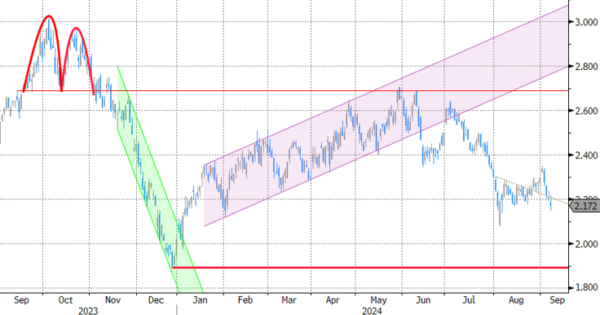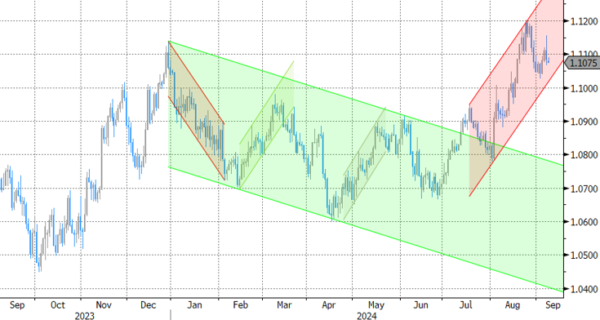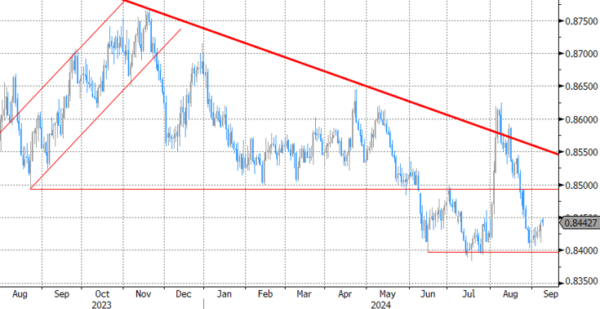Markets
More volatility: yes. More certainty on the outcome of next week’s Fed meeting: no. Friday’s nonfarm payrolls couldn’t settle the rate cut size debate (25 bps vs 50 bps). The forecasted decline in the US unemployment rate, from 4.3% to 4.2%, failed to break the real-time recession indicator (Sahm rule) that rang all the alarm bells last month (3-month moving average of unemployment rate >= 0.50 ppt of the minimum of the 3-month averages from the previous year). The overall miss in payrolls growth was mainly because of a 86k cumulative downward revision to June & July with headline August payrolls being solid (142k vs 165k consensus). Wage growth unexpectedly accelerated by 0.4% M/M to 3.8% Y/Y (from 3.6%). The front end of the US Treasury curve outperformed significantly in a first reaction. The US 2-yr yield tested the early August low at 3.65%, but data weren’t sufficiently weak to force the break going into the weekend. Early USD weakness was undone in the aftermath of the payrolls as well. Especially as US stock markets handled the data badly (-1% to -2.5%), directing some safe haven money into USD. The failed test of support in the trade-weighted greenback (100.83; Dec23 & Aug24 low) gave some technical support as well. Once the payrolls dust really settled, comments by heavyweight Fed governor Waller hit the screens. Renown for his higher-for-longer stance in Q1 of this year, he said amongst others to be open for more forceful rate cuts. Algos picked up the line resulting in a fresh rally at the front end of the US Treasury curve, this time with a new cycle low for the US 2-yr yield around 3.60%. Some nuances are needed though. Waller is ready to act quickly and forcefully (referring to 75 bps rate hikes in inflation battle) should there be a significant deterioration in the labour market. Waller backs a September rate cut, be it with a careful start. So markets kind of overdid it on the first headlines with the US 2-yr yield rebound towards 3.70% this morning.
Today’s eco calendar is uneventful. Wednesday’s US CPI and Thursday’s ECB meeting grab attention later this week. We keep a close eye on risk sentiment following Friday’s nasty losses. More of the same on global growth slowdown worries could help USD find a short term bottom. From a momentum perspective, the jury is out whether such setting could lift core bonds further ahead of key central bank meetings. Both the US and European curves are close to key support levels across all tenors.
News & Views
Chinese consumer prices once again underwhelmed, highlighting an ongoing sluggish domestic demand and underscoring the need for more drastic supportive government measures. CPI rose a mere 0.6% y/y in August, only marginally picking up from July’s 0.5%. It was less than the 0.7% expected and heavily skewed to the upside by food prices (2.8% y/y). Excluding the latter, non-food CPI was barely positive (0.2% y/y). Core inflation (ex. food & energy) came in at 0.3%, slowing from the 0.4% in July. Services inflation amounted to 0.7%, also less than in the month before. A very weak PPI suggests there is little improvement ahead. Factory gate inflation fell a steep -1.8% y/y (-1.5% expected), accelerating the trip into deflation from the -0.8% in July. Food producer prices have greatly fallen in August (-1.3% from -0.7%). This will likely put one of the last remaining solidly rising CPI categories under downward pressure in the coming months. The Chinese yuan slipped straight at the open this morning. USD/CNY rose from Friday’s close sub 7.10 to 7.112 currently.
France has asked the European Commission for more time to submit its debt and deficit reduction plans, both the Financial Times and Bloomberg reported over the weekend. Such an extension beyond September 20 is foreseen in the rules with one EU official anticipating the submission by mid-October, alongside the draft 2025 budget. The request comes after the recent appointment of former Brexit negotiator Michel Barnier as the country’s new prime minister in the wake of the June elections. Those produced a hung parliament with a lot of ideological divide. The 2025 budget will be presented to parliament for debate by October 1 and its approval won’t come easy. The excessive debt procedure that France has been put in by the EC requires the country to bring debt on a sustainable path down through controlling its deficits. Documents last week, however, showed France’s budget gap at risk to rise from 5.5% in 2023 to 5.6% this year instead of government forecasts projecting a decline to 5.1%.
Graphs
GE 10y yield
The ECB cut policy rates by 25 bps in June. Stubborn inflation (core, services) make follow-up moves less evident. Markets nevertheless price in two to three more cuts for 2024 as disappointing US and unconvincing EMU activity data rolled in, dragging the long end of the curve down. The move accelerated during the early August market meltdown.
US 10y yield
The Fed in its July meeting paved the way for a first cut in September. It turned attentive to risks to the both sides of its dual mandate as the economy is moving to a better in to balance. The pivot weakened the technical picture in US yields. A string of weak eco data and a risk-off market climate pushed and kept the 10-yr sub 4%. We think we could be up to three 50 bps rate cuts this year.
EUR/USD
EUR/USD moved above the 1.09 resistance area as the dollar lost interest rate support at stealth pace. US recession risks and bets on fast and large rate cuts trumped traditional safe haven flows into USD. EUR/USD 1.1276 (2023 top) serves as next technical references.
EUR/GBP
The BoE delivered a hawkish cut in August. Policy restrictiveness will be further unwound gradually on a pace determined by a broad range of data. The strategy similar to the ECB’s balances out EUR/GBP in a monetary perspective. Recent better UK activity data and a cautious assessment of BoE’s Bailey at Jackson Hole are pushing EUR/GBP lower in the 0.84/0.086 range.



















